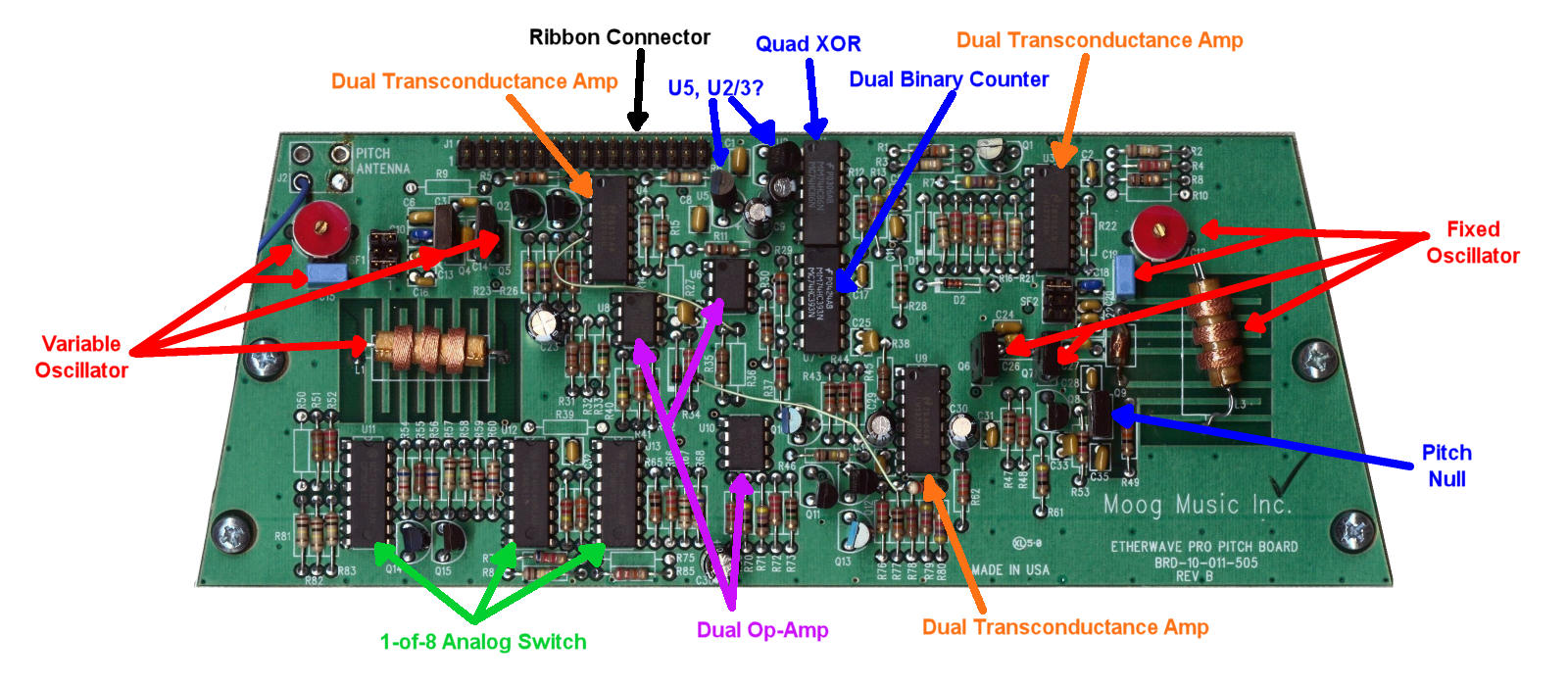Pitch Side Pondering
I scoured the web and found a few more pix. I zipped up all my pix with datasheets for the ICs I could identify on the pitch and volume boards (link).
In it we have views of the front and back of both the volume and pitch PWBs. The volume board has many traces on the top and bottom, it might be only a double layer and therefore traceable given a certain amount of effort. The pitch board unfortunately looks to have more layers inside, with virtually no traces visible on the outer layers. Ah well, we can still wildly guess what might be going on. Here is a quickie annotated view of the component side of the pitch board:

Oscillators: Instead of the usual IF variable inductor can, Bob used a fixed RF choke and a fixed cap + variable cap. The TO3 transistors look quite a bit beefier than the small signal ones used in the EtherWave Standard and Plus. Interesting the way the ground plane under the chokes is "combed" on both sides, presumably so they don't look like shorted windings for any leakage fields (which would hurt Q). I believe Bob stuck something like his standard voltage to capacitance pitch null tuning circuit on the fixed oscillator side, and I assume the oscillator topology is his standard differential pair.
Digital: The front panel octave switch is a big hint that there is almost certainly something digital (gasps, grasps pearls, faints) going on. One way to lower the pitch an octave or two is to divide the heterodyned and filtered wave by 2 or 4, but this gives you a square wave. A better way is to divide both the fixed and variable oscillators by 2 or 4 before heterodyning, and I think that's probably what's going on here. There is a dual 4-bit binary counter super close to the quad XOR gate, and they are located smack dab in the middle of the board, so I imagine the fixed oscillator is fed to one counter, and the variable oscillator to the other. Then counter tap 2 or 4 is picked off both counters and mixed (heterodyned) with one of the XOR gates. If I were doing this I might use three of the XOR gates to do three heterodynes at once (one for each octave) and pick the one I want, and that way the octave switching is simpler. And maybe you could mix in the higher ones to get different waveforms or something.
Analog: It doesn't surprise me to see three dual op-amps (TL072) on the board. And the 1-of-8 analog switches are probably there for voice timbre selection, but what's up with the three dual transconductance amplifiers? They can be used to make VCAs, VCFs, VCOs, and general voltage control. So my guess is voltage controlled mixing and filtering, but could there be something more nefarious (VCO) going on here? Youth wants to know...
CV: The pitch and volume control voltage outputs have to be generated somewhere. If there is true heterodyning going on with the pitch generation (I assume so due to the presence of the XORs, but maybe not), then any voltage derived from that will almost certainly be exponential. Synth modules want a linear response here (1V/octave) so there should be a logarithmic converter somewhere. Over on the volume board (connected via ribbon cable to the pitch board) there is a quad matched transistor array, and I assume that is being used as the heart of a dual CV log converter.
The Crux: If someone who knows would simply tell me whether the EWPro waveforms we hear are either:
1) the direct result of heterodyning
- OR -
2) generated second-hand by a VCO
I'd drop this investigation right now because that's all that really interests me. Keep all other of your other secrets until someone more deserving comes along, or take them to your grave for all I care. But please, spare me the lectures on how it's impossible / wrong for musical engineers (like Bob M.) to engineer musical things (like the EWPro). I get poked in the eye around here enough as it is.



